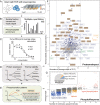KOPI: Kinase inhibitOr Proteome Impact analysis
- PMID: 35906361
- PMCID: PMC9338059
- DOI: 10.1038/s41598-022-16557-w
KOPI: Kinase inhibitOr Proteome Impact analysis
Abstract
Kinase inhibitors often exert on/off-target effects, and efficient data analysis is essential for assessing these effects on the proteome. We developed a workflow for rapidly performing such a proteomic assessment, termed as kinase inhibitor proteome impact analysis (KOPI). We demonstrate KOPI's utility with staurosporine (STS) on the leukemic K562 cell proteome. We identified systematically staurosporine's non-kinome interactors, and showed for the first time that it caused paradoxical hyper- and biphasic phosphorylation.
© 2022. The Author(s).
Conflict of interest statement
The authors declare no competing interests.
Figures


References
Publication types
MeSH terms
Substances
LinkOut - more resources
Full Text Sources
Molecular Biology Databases

